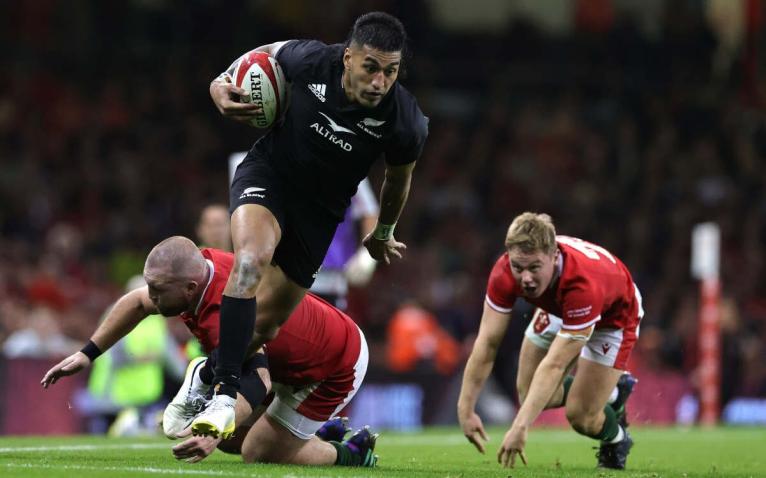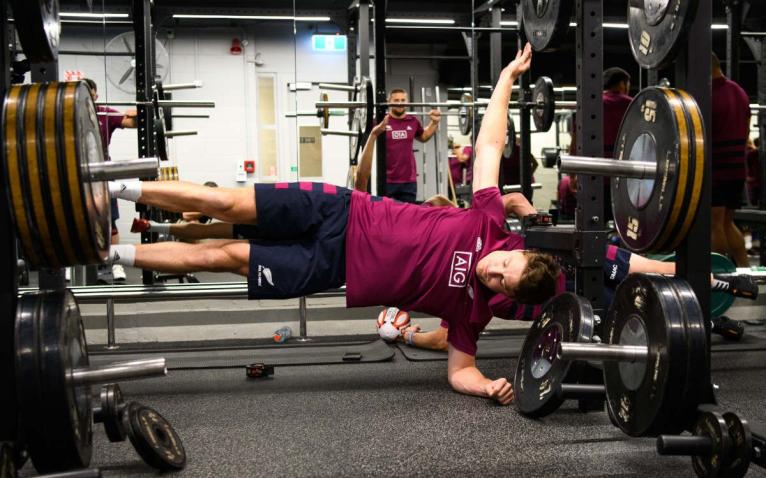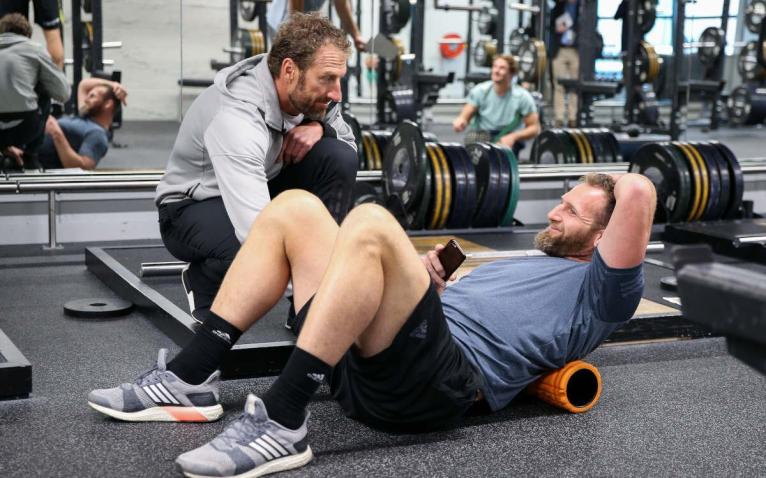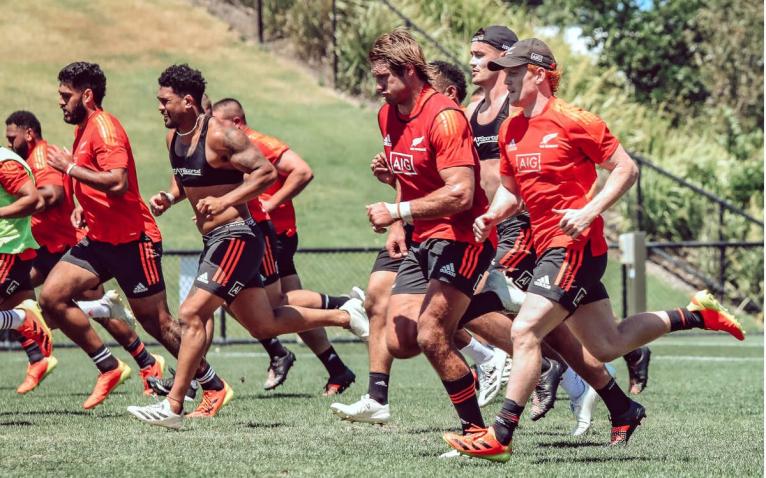Aaron Smith proclaimed last week that the Principality Stadium was his favourite venue in the world, and it was little wonder, given the pocket magician, at 34, scampered away to two fine individual tries.
Jordie Barrett and Rieko Ioane also ran hard and direct in midfield, while piano shifters, Ethan de Groot and Sam Whitelock, both over 120kgs, showed their endurance relentlessly trundling towards the Welsh try-line with tacklers hanging off them.
In all they carried for nearly 400m, where their superior fitness saw the score line run away from Wales, as 23-29, became 23-55, as the All Blacks racked up 26 unanswered points in 28 second-half minutes.
Standing pitch-side, with a ‘water carrier’ vest on was Nic Gill, the head of strength and conditioning. Seven days on from a lung-busting run out against Japan in Tokyo, 6,000 miles away, his charges were looking fresher than ever.
Now 47, the North Islander has been part of the All Blacks set-up for 15 years. With a PhD in Philosophy and Exercise Physiology, and currently an associate professor at the University of Waikato, there are few who know more about the S&C game than the affable Gill. His job, to condition the most successful professional team in sport is all-consuming, and speaking to him on the Autumn Series merry-go-round around Europe, he admits to still gets a buzz out of the role as he approaches his fourth World Cup, because he believes sport is still making small gains in S&C.
“Marathon times are getting quicker, 100m times are still coming down. From a pure athlete’s perspective our knowledge and methods are still creating improvements. Athletes are way better than 15 years ago but there’s still certain limitations to what they can achieve because of the brutal nature of collision sports.”

Gill believes that most gains are being eked out through earlier introduction to best practice. “Most of our improvements in S&C in rugby have come because athletes are starting earlier through academies. Athletes have better knowledge and education around things like nutrition. They’re lifting more efficiently at a younger age, so people are reaching those physical levels earlier because there are more experienced individuals around them imparting knowledge.”
Rugby fans, however, are still hard wired to be impressed by killer stats from the gym, which is why Taniela Tupou bench-pressing 200kgs will still rack up the view count on social media. Gill says his views on S&C gains have evolved over time. “Players were doing a 200kg bench 15 years ago. I’m not saying that isn’t impressive, but the metrics aren’t as important for me these days. I used to chase numbers. I wanted the whole group I was looking after to achieve PBs in their bench press, you know, chinning or squatting more than they did last year, but on reflection, you’re probably opening yourself to more risk of injury. Nowadays the numbers I’m looking at are the GPS numbers, what’s happening on the park that we get from STATSports. That helps me make more informed decisions than 15 years ago, that’s for sure.”
With the stop-start nature of team sports, Gill says understanding how to manage player load is really important in preventing soft tissue injuries, which occur far less than they did historically.
Beaudy’s impressive and his 4.12 bronco is on the money. He can run fast and hold a high speed for a long time. He could probably play four games in a row and still be able to run a try in from 80m. He’s a bit of a freak.
The introduction of smart technology helps. If say Dalton Papalii is taking his time to get back up after contact or is sluggish getting into the defensive line after hitting rucks, making carries and driving mauls, the data can reinforce a hunch of when to call for the replacements bench. “You get it real-time, to reinforce what you’re seeing with your eyes so it’s a pretty powerful thing, and we use it in training as well. The most important thing is understanding what’s normal for the players, or what’s high and low. That gut feeling comes from days, weeks and months on the road with these guys understanding their limits.”
While Gill knows elite performance is far more than numbers, he accepts ultra-competitive athletes like to see gains, and are eager for feedback, which the S&C team pore over. “Nepo Laulala would do a 250kg squat pretty comfortably, if I let him, and I have couple of our props are squatting 270kgs. With the bench press, 180kgs isn’t unusual, and I know Joe Moody can bench 200kgs on a good day.”
As for All Blacks who have blown him away with their natural physical ability, one name springs to mind. “Beaudy’s impressive and his 4.12 bronco is on the money. He can run fast and hold a high speed for a long time. He could probably play four games in a row and still be able to run a try in from 80m. He’s a bit of a freak. As for the speedsters, the fastest player in our squad is Reiko Ioane. Easily under 4.7secs for the 40m. He’s a pretty special athlete because he ticks so many boxes. Often players excel in one area but not in lots of areas, but he does.”

Travelling around the world to Japan, Australia, South Africa, Argentina and Europe racks up the air-miles but also adds a layer of complexity to managing 30 or 40 finely tuned power athletes. Stroking the grey hairs on his chin, Gill, however, takes it in his stride.
“This year is no different to any other All Blacks global season. You’re a travelling team, so you’re used to different hotels, different training fields and facilities. Sometimes in one week you can train on three fields and use two different gyms. It’s just how we roll.”
The ferrying round of personnel, kit and training gear is a balancing act that requires military planning, and there are curve balls like gyms not having certain equipment. “That’s just part and parcel of it. Having enough Watt Bikes, heavy enough weights. Sometimes you turn up places and they don’t have what you were told were there. You just have to make a few adjustments and you’re laughing. Adaptability is the key.”
Richie McCaw had a ridiculous engine. He wasn’t that big, fast or strong but he had a big ticker, and he was very, very tough. People always talk about numbers but they don’t make you the best player on the park.
As for the optimum time to train, Gill says there are variable factors that can differ from week-to-week. “The anchor points when you’re playing and travelling every week are, what time’s kick-off, how far are you travelling and what’s the time zone you are going to and from? When you have that information, you put a structure together that allows you to prepare for the next game. It’s a serious logistical piece.”
The All Blacks management are constantly getting data back on individual fitness targets, but what is paramount to Gill is having players able to play the game that we want to play at the level we want to play it at. “It comes backwards from there. We want to play a certain style of rugby that requires certain physical attributes. We need big boys to be mobile and backs to be fast – not too much has changed in that regard and we don’t overcomplicate it. We don’t expect our props to be running as fast as our wings, but relative to other props, we want them being faster than the opposition.”
While raw physical ability is important, Gill is keen to stress it’s not everything. “Richie McCaw had a ridiculous engine. He wasn’t that big, fast or strong but he had a big ticker, and he was very, very tough. People always talk about numbers but they don’t make you the best player on the park. This is something young kids need to realise. It’s one thing impressing when there’s no in-game decision to be made or no skill involved, but you still need to be able to play the game. They are variables you can’t see on an Excel spreadsheet.”

In a world obsessed with one percenters, the myth that American sport is light years ahead of other team sports, is now misplaced, in Gill’s estimation. “From everything I’ve seen in American sport, I wouldn’t say that they’re ahead of us any more. I think the sports science knowledge of UK, New Zealand and Australia have caught up. That’s because there are more people like me who have been around for a while, whereas a few decades ago, there simply wasn’t the jobs for performance coaches in our field. Now it’s a thriving industry.”
One area Gill says young athletes should treat with caution is social media, which is awash with training tips and miracle gains. “A lot of people are wading through social media now, trying to learn. Unfortunately because there is no filter, half the stuff I see is a load of crap. If you have a scientific brain and you understand the human body, then you can self-filter but the danger is when people don’t know enough. Then they’re at risk of being led down the garden path. I learn from reading and talking to people. There is informative content on social media but I always ask the question, what can help the All Blacks, and go from there.”
Life is hard, and it’s not getting any easier. I think professional sport just reflects societies complexities. People have lots of things going on in their lives and the more open they are with us, the more we can get them help.
When asked about what the toughest part of the job is, without missing a beat, he says it is being away from his family. Wife Mel, daughters Olyvia and Grayce and the lush plot of land they live on near Tauranga.
With the travelling and frustrations of modern-day life, one aspect Gill is tuned into, and feels has changed for the better, is communication between players and management over mental health, with a high-profile case of this being Michael Hooper pulling out of the Wallabies trip to Argentina this summer because he wasn’t ‘in the right mindset.’
In a roll that is full-time S&C coach, and part-time counsellor, judging the mental health of players on tour is paramount. “Look, life is hard, and it’s not getting any easier right now. I think professional sport just reflects societies complexities. People have lots of things going on in their lives and the more open they are with us, the more we can get them help. With ‘Hoops’, I don’t know the ins and outs, but good on him for being open and speaking about when he wasn’t feeling himself. Your brain is as important as your physical wellbeing.”

With a World Cup veering onto the horizon, Gill knows that expectations will be unrelenting, after what has been an indifferent year for the All Blacks on the pitch, and his job will not get any easier. However, he still feels like he has one of the best jobs in rugby. “It’s about understanding the science of the human body and then understanding your sport. From there you can figure out how to maximise physical preparation, nutrition, recovery, practicing the game and getting all those things right, because the templates, spreadsheets, and all the data in the world can look flash on a computer screen but what it actually looks like in practice is another thing. That’s where the advances are being made. Leveraging, sitting back and reflecting on your experiences and coming up with a plan.”
In a matter of weeks, Gill will be back at the family orchard doing just that because 2023 promises to be seismic year.


I wonder if Nick will tweak the power/stamina balance of the AB forwards next year, in light of the size and power of the French/Irish/Bok etc forwards. Someone like Brodie Retallick, for instance, compared to the musculature of Eben Etzebeth, seems skinny - Brodie looks like he could carry another 10kgs, increase his power and not compromise his stamina and mobility?